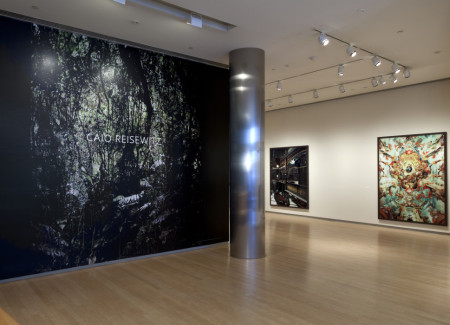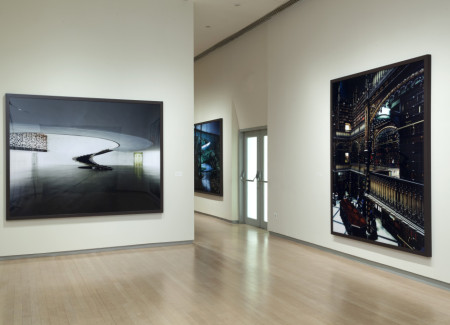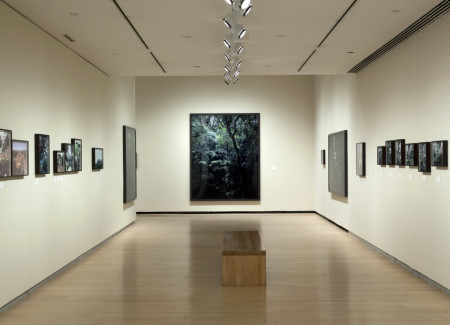JTF (just the facts): A total of 42 large scale color photographs, framed in dark brown wood and unmatted, and hung against ivory colored walls in a series of connected spaces on the main floor of the museum. All of the works on view were made between 2003 and 2013. The show includes a mix of 22 chromogenic prints (generally in large to monumental sizes, including 1 diptych) and 20 inkjet prints (generally in small sizes). The exhibit was organized by Christopher Phillips and is the artist’s first major solo show in the US. (Installation shots below ©International Center of Photography; photographs by John Berens.)
Comments/Context: From afar, the artistic career of Brazilian photographer Caio Reisewitz has the feel of a carefully controlled science experiment or the arc of a well plotted novel. It’s a classic what if story, played out over more than a decade – what if we took a talented South American artist, steeped him in the rigorous teachings of the Düsseldorf school at an early age, and then returned him to his native land to see how the clash of the training and the local environment would influence his art making? As seen on the walls of this exhibit, the results began with very recognizable German traits, but quickly evolved into something more improvisational and deeply rooted in the complex economic and environmental issues facing his home country – in short, the strict foundation went a bit feral in the sultry heat.
The first pictures in the show find Reisewitz shoehorning local content and issues into a German wrapper. Colonial remnants and Modernist masterpieces are given an echo of Candida Höfer, with exuberant painted churches, ornate library reading rooms, and sleekly curved architecture meticulously captured as emblems of power. A broad landscape vista of São Paulo brings in the romance of Elger Esser, with layers of towering white clouds hovering over sparkling apartment buildings; what gives the image its mystery is the dense sweep of dark forest that seems to engulf the city, the uneasy balance between nature and urbanization writ large. Each picture is executed with obvious Düsseldorf-style production values: monumental scale, crisp detail, glossy finish, and a powerful wall presence.
When Reisewitz turns his attention to the Brazilian jungle, a welcome looseness begins to creep into his work. Unlike Thomas Struth’s Paradise series, Reisewitz’ straight jungle scenes teem with energy and movement, bringing the unruly vegetation right into the viewer’s space; these aren’t clinical jungles from afar, they are vibrant, immediate experiences of nature. Eye popping red dirt and still smoking clear cut forests tell the intertwined story of industrial coffee production and its impact on the environment, and provide a powerful foil (both visual and historical) for lush greenness of the pristine forests.
The real and original innovation in Reisewitz’ work comes when he allows collage elements (either digitally inserted or cut and paste/rephotographed) to interrupt his jungle scenes. Here the ecology becomes artificial, with images grafted together into subtle compositions – an image of a shadowy, vine draped clearing, with moss covered rocks and a quietly babbling stream turns out to be a piece part fabrication, a composite of anonymous sliced fragments that assemble the ecology into a shifting whole. A few push this creation to wider limits, turning forests into improvisational collections of interleaved visual ideas, tinted and painterly in their flatness. It’s as if Reisewitz has been hard at work “constructing” the illusion of nature, building up a shifting unreality from various disconnected memories.
Other collaged images have a more overtly jarring effect. In these pictures, a grand jungle view (with a waterfall or a cluster of large leaf vegetation) is suddenly (and often perplexingly) host to a tiny cluster of shacks or a larger sweep of slums; the favelas have encroached on the natural world, inserting themselves in the most unlikely of places. Here the duality of modern Brazil (city and rainforest) is captured in surreal single frame allegories, where miniscule shanty towns and apartment blocks made from cinder blocks and plywood conquer the dappled foliage like insidious infesting viruses. In some cases, the houses are nestled amid the branches and hard to find, forcing the viewer to search for the hidden incursion, while in others, the scene has become a more uneasy hybrid, with both sides tussling for dominance. The sense of wasteful neglect and the exploitation of vanishing nature becomes more prominent as these buildings unrelentingly march on.
Seen together, Reisewitz’ work feels like a gradual progression, an internalization of the lessons from his studies and an evolution into a more personal style that incorporates parts of this framework but leaves behind some of its structured limits. His recent photocollages are smartly open ended and multivalent, bringing together the opposing forces that challenge his country, but doing so with more spontaneity and messy complexity than his German training might normally allow. As his style becomes freer, his messages about the choices Brazil faces are becoming less deadpan and more urgent.
Collector’s POV: Since this is a museum show, there are of course no posted prices. Caio Reisewitz is represented by Luciana Brito Galeria in São Paulo (here). His works have very little secondary market history, so gallery retail remains the best option for those collectors interested in following up.









